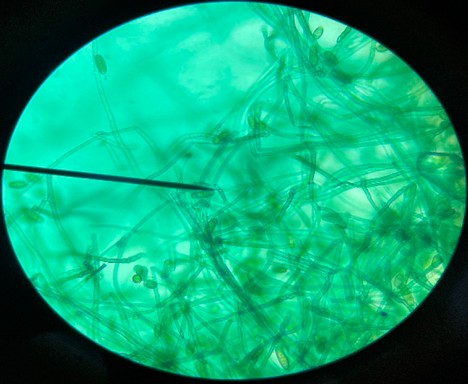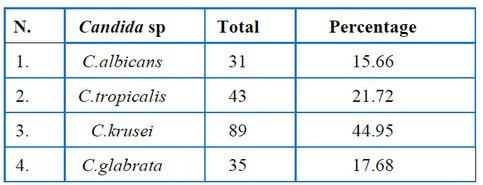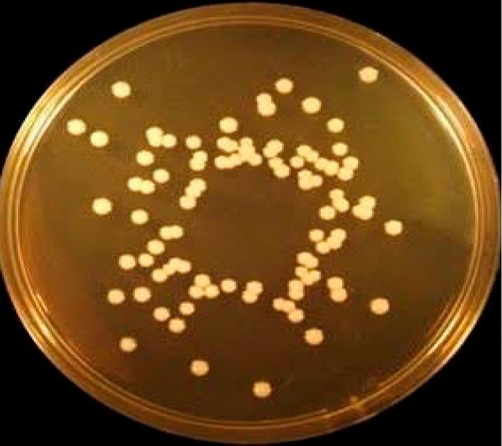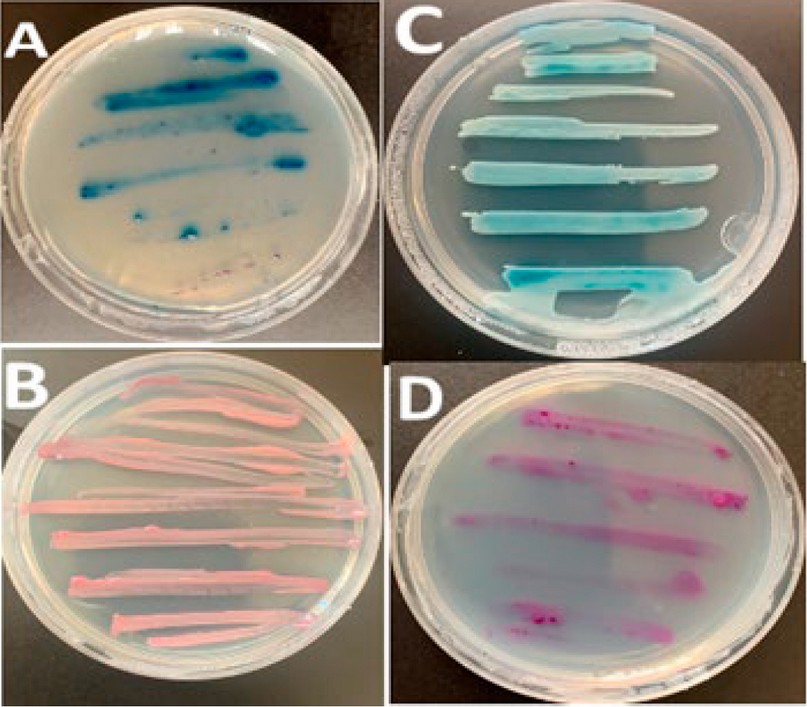2023.08.03.115
Files > Volume 8 > Vol 8 No 3 2023 > Diyala 3
Contamination of poultry feed with Candida species in Duhok city using CHROMAgar
Lina F. Hussein1*, Asia A. M. Saadullah2
1 Biology Department, College of Sciences, University of Duhok, Duhok, Kurdistan Region, Iraq. [email protected]
2 Biology Department, College of Sciences, University of Duhok, Duhok, Kurdistan Region, Iraq. [email protected]
* Correspondence: . [email protected].
Available from. http://dx.doi.org/10.21931/RB/2023.08.03.115
ABSTRACT
This study aimed to isolate and identify Candida species that contaminate poultry feeds in Duhok province. Using differential media and CHROMagar (CAC) as selective media, sixty samples of poultry feeds were collected and analyzed to isolate and classify Candida species. In this analysis, 189 Candida isolates were found from 60 samples. Germ tube tests, inoculation on commercially available CHROMagar, and chlamydospore formation were performed on these isolates. The most common Candida identified was Candida krusei (44.95%), followed by Candida tropicalis (21.72%) and Candida glabrata. (17.68%), and Candida albicans (15.66%).Particularly useful for quickly identifying common yeast species is CHROMagar. Its ability, together with the capacity to track mixed Candida spp. Cultures lead to enhanced and, in the mycology and clinical microbiology laboratories, streamline the workflow, also in low-resource conditions.
Keywords: CHROMO agar, Candida species, Duhok, identification, poultry feed
INTRODUCTION
Grains such as maize, barley, or wheat, cake meal, oilseeds (from oil-producing seeds are derived predominantly like soybeans), peanuts, sunflower seeds, cotton seeds, and even animal protein products, including meat, fish meal, and slaughterhouse offal, bone meal, and bird meals are all examples Because these feeds are intended to be the birds' sole source of nutrition, they typically include essential vitamin and nutrients additives. While different farm animals have additional nutritional requirements, to enable the animal's potential expression under certain environmental conditions, the amount of dietary energy and associated nutrients should be high enough while staying within economic constraints 16. The second most popular meat in the world is poultry, accounting for approximately 38% of total meat consumption 17. Protecting poultry products demonstrates the importance of efforts in assessing and detecting microbial hazards, which pose a significant risk to customers. Poultry feed is one of the most common causes of contamination in poultry products. In developing countries, the protection and consistency of poultry feeds are currently a significant concern; feed safety is a basic necessity for all birds 18. The feed Unsafe may result in substantial financial loss. Microorganisms in chicken feed come from various sources, including contaminated feedstuff/ingredients. Plant and animal origin, livestock feed handlers (preparers and those who feed the animals), vectors (which pick up and deposit organisms on stored feedstuff/feed), and containers used to prepare and pack feed 14. Candida species have long been thought to be a reliable source of diarrhea, but this has not been confirmed. One of the most common fungal infections is Candida albicans 1. It is a diploid fungus that can develop as filamentous cells or yeast and, in humans, is responsible for genital infections and is opportunistic in the mouth; foodborne diarrhea is also related to it. The Candida albicans species is a budding cell with a spherical or ovoid shape that contains pseudo hyphae in cultures and tissues 2. The existence of microscopic fungi affects the nutritional value of feeds and their organoleptic properties. Other microorganisms like molds can assimilate and have the most widely available resources in the compounds they grow on. Spoilage will result in nutrient losses ranging from 5 to 100 % per Humans can get diseases from domestic poultry birds in two different ways. First is coming into contact with chicken faces or sick Chickens, which a caretaker or a veterinarian usually handles. Ingestion of disease-causing pathogens that had colonized the ill Chicken/eggs is another. A person may become infected if they eat these eggs. 2 This study has aimed to isolate and classify Candida spp. from poultry feeds in the Duhok region of Iraq using differential and CHROMagar techniques.
MATERIALS AND METHODS
Collection of Samples
In this study, a total of sixty poultry feed samples (500g each) from various farms, which included chickens, farms, feeds, and feedstuffs for the feeds, were handled as ready-to-serve after being obtained from various farms and feed depots, as well as Veterinarian Service Centres in the government areas of Duhok. Three points in the upper third, three in the middle third, and three in the lower third of each barrel were used to obtain samples. Every sample was held at room temperature (around 25°C) in sterilized polythene packets with proper labeling. The specimens used in this study had no preservatives or additives that could interfere with fungal growth, and they were either analyzed right away or held for 2-3 days before being analyzed.
Preparation of samples
The dilute plate technique was used to enumerate and isolate fungi. To make a standardized suspension, 90 ml of autoclaved distilled water is mixed with ten grams of each representative sample and shaken for 30 minutes. Each dilution yielded five dilutions: 10-1, 10-2, 10-3, and 10-4 for each feed sample 3. The spores were then aseptically cultured in triplicate on each of these three different media and using 0.1ml of the dilution 10-4 inoculated by spread plate technique to achieve uniform distribution. These media are SDA (Sabouraud Dextrose Agar), MEA (Malt Extract Agar), and PDA (Potato Dextrose Agar) incubated for two to three days at 25- 37°C, as the fungal growth is monitored at intermittent intervals.
Candida spp. isolation and identification
All samples were incubated separately at 25-37°C on 4 percent (SDA). That development and growth were monitored regularly, and samples without yeasts were removed from the analysis after 72 hours. The gram staining was performed on colonies that had developed in SDA for 2-3 days, were paste rigid, 0.5-1 mm in diameter, cream or white-colored, uniformly bounded and had distinct yeast scents.
Prolonged budding yeast cells or oval, gram-positive in gram staining, pseudo-hypogenic yeast cells, individual, occasionally double, triple blastospore clusters were isolated as a Candida species. Microorganisms identified as Candida spp. were transferred to SDA for gram staining evaluation and have been obtaining pure cultures (BioMerieux, France).
Culture media /chrom agar candida
After streaking a loop full of culture onto CHROMagar Candida medium and then incubating at 37°C for 48 hours, all colonies of Candida spp. isolated on PDA, SDA, and subculture. It is a differential and selective media that aids in the immediate presumptive identification and isolation of many clinically significant Candida species based on the characteristic types and color of the colonies 4,5.
Where instructed by the manufacturer (NEOGEN –UK, ACUMEDIA –LAB). Media CHROM agar containing substrate chromogenic that reacts with Candida species' secreted enzymes to produce colonies of various colorations, allowing species recognition according to the author 4,5.
GTT (GERM TUBE TEST)
When incubated in serum of human blood for 2 hours at 37 degrees Celsius, this test is a simple way to differentiate between C. albicans and C. dubliniensis due to its ability to create small, delicate-looking tubes classified as germ tubes.
Pseudo-hyphae are not the same as germ tubes since the mother cell's daughter cells are elongating and do not shrink at the point of origin 6,7.
Formation of Chlamydospores
The primary media culture was used to distinguish an isolated colony. Three parallel streaks around halves an inch over at a 45-degree angle to the culture medium were used to inoculate the cornmeal agar layer. Chlamydospores are terminal spores that are wide, extremely retractile, and have a thick wall (figure 1). Candida albicans were identified using this test 8.

Figure 1. Chlamydospore formation under 40X light microscopy.
RESULTS
The Outcomes of Isolation and Identifications
The results in Table 1 illustrate the 60 samples of poultry feed tested; 189 Candida species have been found. The highest number of isolates was 89 isolates of Candida krusei (44.95%), followed by C.tropicalis 43 (21.72 %) C.galbrata 35 (17.68%), and the lowest number was C.albicans 31(15.66%).

Table 1. Shows the percentages of candida species in poultry feeds.

Figure 2. Creamed-coloured colonies of Candida sp. on SDA.
A yeast selective and differential media is CA Candida sp. (CHROM agar), which enables mixed yeast cultures of clinical samples to be identified. C. albicans can be distinguished from many other Candida species using this medium. Table 2 illustrates that the coloring of yeast communities and colonial morphology are determined via CHROM agar within the agar medium. C. albicans strains produce p-N-acetyl galactosaminidase and react with the chromogenic hexosaminidase substrate (chromophore) integrated into the medium. Green colonies (figure 3 C), typical of all C. albicans isolates, appear after 48 hours of incubation.

Table 2. Color of different Candida species. on CHROM agar for identifications.

Figure 3. (A) C. tropicalis on CHROMagar (B) C. glabrata on CHROMagar (C) C. albicans on CHROMagar (D) C. krusei on CHRO agar
DISCUSSION
A vast range of microorganisms may be transported by animal feed. The principal route of inoculating feed ingredients is the transfer of soil to standing crops by wind, rain, mechanical agitation, or insects. Some microorganisms have evolved to the dry and low-nutrient conditions of soil and can thrive in comparable niches on growing crops. Animals defecating in the agricultural area or crop fertilization with manure can also transmit gastrointestinal infections into the food chain. During storage, other microbes are added. In general, whether a microbe will grow or survive is determined by the amount of accessible water in the feed matrix. Poultry products are an essential source of protein to meet the dietary requirements of the ever-growing human population. Since protecting poultry products for human consumption is a World Health Organization (WHO) criterion, a study was conducted to establish and examine the Candida spp. contaminant available for commercial poultry feed. Pathogens could reach human food sources through microbial contamination of poultry feed.
Fungi and bacteria in the feed also reduce feed quality through physical damage to the feed, adversely affecting the organoleptic properties of the feeds in the process15. Yeasts are eukaryotic unicellular fungi present ubiquitously in the environment, including soil and the skin of humans and animals 11. Contamination of feeds with pathogenic microflora constitutes a severe threat to animals and humans 13. Candida species colonists on SDA (Sabouraud Dextrose Agar) medium appear fluffy, rounded, wrinkled to smooth, slimy, and creamy white, as well as a distinct feature over the first two to three days, the yeast develops rapidly (figure 2). Candida spp. Isolates were found to be spherical to oval with some budding when stained with lactophenol cotton blue. Within two hours of incubation, figure 4 shows the GTT (germ tube test) was established, which is a distinction between C. albicans and C. dubliniensis 9. According to the study's results and Sheppard et al's observations, all Candida albicans tested positive in the germ tube examination 9. Those who claimed that all non-species of C. albicans were negative for the germ tube test from the colony, whereas all C. albicans isolates were positive for the germ tube test 4.
Consequently, the elevated Candida rebound may suggest a risk to the livestock. An overall prevalence of Candida species, a public safety issue, could suggest a clear health risk from farmed animals consuming Candida-contaminated feed 10. Some microbes, particularly molds, have adapted to the low moisture content of stored seeds and grains and thrive within them. Others will develop spores or survive until moisture levels are high enough for bacterial activity. Contaminating microorganisms can harm feed quality by lowering dry matter and minerals, generating musty or sour odors, caking the feed, and releasing toxins. Finally, feed can be a vehicle for infections in animals and humans. The kind of feed, processing procedures, and storage conditions can all impact the population numbers and microbe species present 12.
CONCLUSIONS
As a result, the findings suggest that poultry feed production is sanitary a matter of public health. Starting with the harvesting of feed ingredients and ending with the packaging, processing, storage, and transporting of feeds, appropriate diagnosis of animal feed and implementation of good hygiene like HACCP (Hazard analysis critical control point) is required. Finally, the promotion of packaged feeds is essential for disease prevention, and vitamin A supplements are required. Microbial pathogens and microorganism counts were discovered in the various poultry feeds examined in this study. This represents the degree of hygienic procedures and biosecurity used in feed processing, storage, and handling. Feed additives that avoid harmful microorganisms must be promoted ever to be added to poultry feed. The above results highlight the importance of ongoing quality control of commercially available feeds, essential to keep microbiologically secure livestock feeds and poultry products destined to be consumed by humans.
Funding: This research received no external funding.
Conflicts of Interest: The authors declare no conflict of interest.
REFERENCES
1. Martins N, Ferreira IC, Barros L, Silva S, Henriques M.( 2014). Title of Site. Available online: URL (accessed on Day Month Year). Candidiasis: Predisposing factors, prevention, diagnosis and alternative treatment. Mycopathologia. 2014; 177(5–6):223–240.
2. Ryan KJ, Ray CG. (2004). An introduction to infectious diseases 4th Ed. New York, Sherri's medical microbiology. (2004); pp. 661–663.
3. Pitt, Hocking A.( 2009). Fungi and food spoilage. 3rd ed. Berlin,- Germany: Springer; 2009. Printing. Vol. 2. SAS Institute Inc, SAS Campus Drive, Gary, North Carolina.
4. N. M. T. Jebril; R. Boden; C. Braungardt. "REMEDIATION TECHNIQUE FOR CADMIUM CONTAMINATED GROUNDWATER: A SYSTEMATIC REVIEW. "ANBAR JOURNAL OF AGRICULTURAL SCIENCES, 21, 1, 2023, 1-18. doi: 10.32649/ajas.2023.178800.
5. Mathavi, S., Sasikala, G., Kavitha, A. and Priyadarsini, R. I. (2016). CHROMagar as a primary isolation medium for rapid identification of Candida and its role in mixed Candida infection in sputum samples. Indian J. Microbiol. Res. 3(2):141-144.
6. Al-Rawi, K. F.; Ali, H. H.; Guma, M. A.; Alaaraji, S. F. T.; Awad, M. M. The Relationships of Interleukin-33, Ve-Cadherin and Other Physiological Parameters in Male Patients with Rheumatoid Arthritis. Pertanika J Sci Technol 2022, 30 (1), 123–140.
7. Deorukhkar, S. C. & Saini, S. (2014). Laboratory approach for diagnosis of candidiasis through ages. Int.J.Curr.Microbiol.App.Sci., 3, 206-218.
8. Abdul-Lateif, K. M. & Abdulateef, S. M. The effect of injecting hatching eggs with different concentrations of biotin on the quality and physiological characteristics of the hatched chicks. Iraqi J. Vet. Sci.2012, 26.).
9. Sheppard, D. and Lampriis, H.W. (1998). Antifungal agents. Ini B.G. Katznny(Ed.). Basic and clinical pharmacology. 7th ed. Pp. 780-787. McGrew- Hill.Newyork.
10. Srinivasan L, Kenneth J. (2006). Antibiotic susceptibility of Candida isolates in a tertiary care hospital in Southern India. Int J Med Microbiol; 24:1-8.
11. R. Montes de Oca, A. Salem, A.E. Kholif, H. Monroy, L.S. Pérez, J.L. Zamora, A. Gutiérez, A.K. (2016). Puniya Yeast: description and structure Pages 4–13 in Yeast Additive and Animal Production, PubBioMed Central Research Publishing Services, Tamilnadu, India (2016).
12. K.G. Maciorowski P. herrera , F.T. Jones , S.D. Pillai, S.C Ricke. (2007). effects on poultry and livestock of feed contamination with bacteria and fungi. https://doi.org/10.1016/j.anifeedsci.2006.08.006.
13. Mansoor, S. S.; Al-Esawi, J. S. . .; Al-Falahi, M. N. ASSESSING The Efficiency Of Cement Kiln Dust For Heavy Metals Removal From Simulated Polluted Water. JLSAR 2023, 4, 45-52..
14. Ali, H. H.; AL-Rawi, K.; Khalaf, Y.; Alaaraji, S.; Abraham, B.; Awad, M.; Al-ani, O.; Al-ani, F.; Ali, A. T. Serum Caveolin-1 Level Is Inversely Associated with Serum Vaspin, Visfatin, and HbA1c in Newly Diagnosed Men with Type-2 Diabetes. Rep Biochem Mol Biol 2022, 11 (2).
15. Cegielska-Radziejewska, R., Stuper, K. and Szablewski, T. (2013). Microflora and mycotoxin contamination in poultry feed mixtures from western Poland. Annals of Agricultural and Environmental Medicine , 20(1): 30 – 35.
16. Alaaraji, S. F. T., Awad, M. M. & Ismail, M. A. Study the association of asprosin and dickkopf-3 with KIM-1, NTpro-BNP, GDF-15 and CPP among male iraqi with chronic kidney disease. Systematic Reviews in Pharmacy 11, (2020).
17. Wanjari, N. , & Waghmare, J. (2015). Phenolic and antioxidant potential of sunflower meal. Advances in Applied Sciences and Research, 6, 221–229.
18. Aubrey M. , Emalie Th. , André G. (2020). Chapter 5 - Microbiological considerations in food safety and quality systems implementation Food Safety and Quality Systems in Developing Countries. 2020, Pages 185-260.
Received: 25 June 2023/ Accepted: 26 August 2023 / Published:15 September 2023
Citation: Hussein L F, Saadullah, A A M.Contamination of poultry feed with Candida species in Duhok city using CHROMAgar. Revis Bionatura 2023;8 (3) 115 http://dx.doi.org/10.21931/RB/2023.08.03.115
